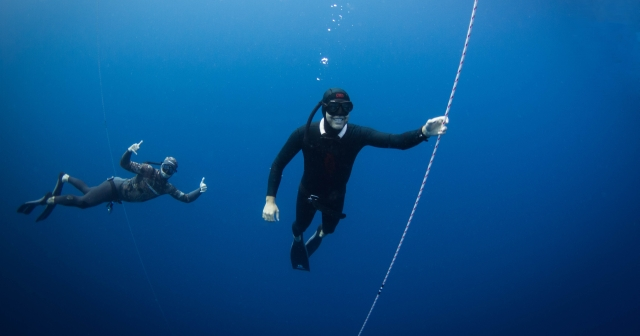COVID-19 Tuesday Series - Becoming a Better Freediver
by FII - April 27th
With the onset of the COVID-19 pandemic, many things have dramatically changed in our lives. Social distancing will be the norm for a while, and we all are trying to figure out how to go about our lives with these new challenges. For most of us, being locked at home is not the ideal way of spending time, but if this is how things are going to be, we may as well get the most out of it. In this series of blogs, we will share with you how to become better freedivers in spite of self-isolation while following the guidelines on social distancing.


In the COVID Tuesday series, we will cover the following topics:
- 1. Focus Training
- 2. Proper Use of O2/CO2 Tolerance Tables
- 3. How to Learn Hands-Free Equalization Technique
- 4. Distance Learning - Continued Education
- 5. Breathing Exercises
Focus Training
I think we all can agree that freediving performance is a combination of both physical and mental ability. In any sport, the higher you climb on the performance ladder, the more important the mental aspect is. In freediving, however, the mental game starts right from the get-go.
Most of us are guilty of regularly scheduling our dive sessions, cross-training workouts, or stretching, but not everyone reserves time for mental training. Mental preparation is often pushed aside because the physical training seems more important and tangible. However, your brain responds to conditioning in the same way your muscles do; if you put in the reps and volume, you will see the results.
Though different freedivers may struggle with different mental hurdles in their performance, it all boils down to one crucial mental skill, which is the base for developing other skills and achieving pretty much anything. This is the ability to focus.
Focus means being able to lock your mind onto an objective and eliminate any disturbance. This is how we can quickly learn new skills or correct mistakes in already habitual techniques. This is how we can learn how to relax all the muscles that are not needed at a given moment. This is how we can stay relaxed despite an urge to breathe deeply or when we feel strong chest compression at depth. This is how the expert freedivers can stay “in the zone” and let their bodies execute the dive for them.
Here are two exercises I like to use to train my ability to focus.
The Clock
Sit comfortably in a quiet room with an analog clock that has a second hand. Empty your mind and focus on the second hand. Following the hand should be the only thing on your mind. See if you can follow it for fifteen seconds without any other thought entering your mind. It is harder than you may think. Once something else enters your mind, regain your focus and start again. Once you can do two full minutes, you have created a good base for more creative training. Now you can have a TV or radio playing in the background to increase the difficulty by adding outside stimuli. You can also add inside stimuli, such as holding your arms in the diving position with one hand on your nose and one arm over your head. Just don’t add a new stimulus every time. Make sure you make good progress before you try a new challenge. Add a new stimulus once a week, then come back to the basic quiet room and see how far you can go with it.
Bring Yourself Back
Sit comfortably in a quiet room, close your eyes, and focus your attention on diaphragmatic breathing—the same breathing pattern you have learned in your F.I.I. course for breathe-up. Visualize your inhalation as a white fog filling up your lungs from the bottom. On exhalation, switch your focus to the number “1.” You can repeat the sound of it to yourself or visualize the number in front of you. On inhalation, again visualize the air as a fog filling up your lungs from the bottom, and on your exhale, focus on the number “1.” When you first find your mind distracted or wandering, gently return to your focus in the following way: Concentrate on inhalation and visualize the air as a fog filling your lungs from the bottom. On your exhale, focus on the number “2.” With each distraction, recognize that you are drifting, bring yourself back, and increase the number you focus on by one.
You can choose one exercise or the other, or you can alternate them between your sessions to have some variety, but most importantly, put them on your schedule and do them regularly.
Next Tuesday we look forward to sharing the Proper Use of O2/CO2 Tolerance Tables! If you have a topic that you'd like covered, feel free to put it in the comments section. Stay safe out there!
